Emulsion Mixtures of Fractionated Reclaimed Asphalt Pavement and Quarry By-Products: A Laboratory Evaluation
Abstract
:1. Introduction
2. Objective and Scope
3. Materials
3.1. Aggregate Composition
3.2. Anionic Emulsion
3.3. Residual Asphalt Content
4. Methods
4.1. Indirect Tensile Strength and Tensile Strength Ratio
4.2. Resilient Modulus and Permanent Deformation
5. Results
5.1. Tensile Strength and Moisture Susceptibility
5.2. Anisotropic Moduli and Permanent Deformation Characterizations
6. Conclusions
- An increase in FRAP content resulted in an increase in the strength and moisture resistance of the bituminous EAMs. The EAM containing FRAP and QB (30R-70QB) exhibited the highest ITSDry and ITSWet values. These observations indicate a superior FRAP and QB aggregate interlock and compatibility with emulsion stabilization compared to crushed limestone.
- EAMs containing 50% or more FRAP content satisfied Asphalt Academy’s Tensile Strength Ratio (TSR) requirements, indicating sufficient moisture resistance under moisture intrusion.
- An appreciable increase in vertical resilient modulus was observed with the inclusion of 50% FRAP content in EAMs (50R-0QB). In addition, the introduction of FRAP material (25R-0QB, and 50R-0QB) increased the stiffness of EAMs for base layer applications.
- The higher anisotropic moduli ratios of the blends revealed that the EAMs prepared using FRAP (25R-0QB, and 50R-0QB) were less susceptible to deformation under principal stress reversals under a moving wheel load.
- Moreover, a significant reduction in permanent deformation of about 22% was observed in EAMs containing FRAP (50R-0QB and 25R-0QB) compared to the control mixture.
Author Contributions
Funding
Institutional Review Board Statement
Informed Consent Statement
Data Availability Statement
Acknowledgments
Conflicts of Interest
References
- Anderson, J.R.; Thompson, M.R. Characterization of Emulsion Aggregate Mixtures. Transp. Res. Rec. 1995, 1492, 108–118. [Google Scholar]
- Herrington, P.R.; Ball, G.F.A.; O’Halloran, K.; Land Transport New Zealand. Aquatic Ecotoxicity of Cutback Bitumen; Land Transport New Zealand: Wellington, New Zealand, 2006; ISBN 0478253966.
- George, K.P. Stabilization of Sands By Asphalt Emulsion. Transp. Res. Rec. 1976, 593, 51–56. [Google Scholar]
- James, A. Overview of Asphalt Emulsion; Transportation Research Circular; Transportation Research Board: Washington, DC, USA, 2006; pp. 1–15. [Google Scholar]
- SABITA. Technical Guideline: Bitumen Stabilised Materials (TG2); SABITA: Cape Town, South Africa, 2002; ISBN 978-1-874968-77-1. [Google Scholar]
- Finn, F.N.; Hicks, R.G.; Kari, W.J.; Coyne, L.D. Design of Emulsified Asphalt Treated Base Courses. Highw. Res. Rec. 1969, 238, 58–75. [Google Scholar]
- Darter, M.I.; Ahlfield, S.R.; Wilkey, P.L.; Devos, A.J.; Wasill, R.G. Design of Emulsified Asphalt-Aggregate Bases for Low Volume Roads. Transp. Res. Rec. 1979, 702, 164–172. [Google Scholar]
- Schmidt, R.J.; Santucci, L.E.; Coyne, L.D. Performance Characteristics of Cement-Modified Aspahlt Emulsion Mixes. In Proceedings of the Association of Asphalt Paving Technologists, Houston, TX, USA, 12–14 February 1973. [Google Scholar]
- Horak, E.; Rust, F.C. Performance and Behaviour of Bitumen Emulsion Treated Road Bases in South Africa. In Proceedings of the 7th International Conference on Asphalt Pavement, Nottingham, UK, 16–20 August 1992; pp. 118–134. [Google Scholar]
- Wilde, W.J. Thickness Design Method for Bituminous-Stabilized Aggregate-Surfaced Roads. Transp. Res. Rec. 2007, 1, 123–129. [Google Scholar] [CrossRef]
- Moaveni, M.; Abuawad, I.; Hasiba, K.; Zhang, D.; Tutumluer, E. Characterization of Emulsion Bitumen Stabilized Aggregate Base. In Proceedings of the Advances in Transportation Geotechnics II—Proceedings of the 2nd International Conference on Transportation Geotechnics, ICTG 2012, Hokkaido, Japan, 10–12 September 2012; Taylor and Francis—Balkema: Abingdon, UK, 2012; pp. 376–381. [Google Scholar]
- Sangiorgi, C.; Tataranni, P.; Simone, A.; Vignali, V.; Lantieri, C.; Dondi, G. A Laboratory and Filed Evaluation of Cold Recycled Mixture for Base Layer Entirely Made with Reclaimed Asphalt Pavement. Constr. Build. Mater. 2017, 138, 232–239. [Google Scholar] [CrossRef]
- Ullah, S.; Tanyu, B.F. Methodology to Develop Design Guidelines to Construct Unbound Base Course with Reclaimed Asphalt Pavement (RAP). Constr. Build. Mater. 2019, 223, 463–476. [Google Scholar] [CrossRef]
- Qamhia, I.I.A. Sustainable Pavement Applications Utilizing Quarry By-Products and Recycled/Nontraditional Aggregate Materials. Ph.D. Thesis, University of Illinois at Urbana-Champaign, Urbana, IL, USA, 2019. [Google Scholar]
- Qamhia, I.I.A.; Tutumluer, E.; Ozer, H.; Boler, H.; Shoup, H.; Stolba, A.J. Durability Aspects of Chemically Stabilized Quarry By-Product Applications in Pavement Base and Subbase. Transp. Res. Rec. 2020, 2674, 339–350. [Google Scholar] [CrossRef]
- Husain, S.F.; Kong, T.; Tutumluer, E.; Marienfeld, M.; Qamhia, I.I.A. New Geotextile Quarry By-Product Geocomposite System for Permanent Road Foundation. In Proceedings of the Geosynthetics Conference 2023, Kansas City, MO, USA, 5–8 February 2023. [Google Scholar]
- Plati, C.; Cliatt, B. A Sustainability Perspective for Unbound Reclaimed Asphalt Pavement (RAP) as a Pavement Base Material. Sustainability 2019, 11, 78. [Google Scholar] [CrossRef] [Green Version]
- Dong, Q.; Huang, B. Laboratory Evaluation on Resilient Modulus and Rate Dependencies of RAP Used as Unbound Base Material. J. Mater. Civ. Eng. 2014, 26, 379–383. [Google Scholar] [CrossRef]
- Al-Qadi, I.L.; Elseifi, M.; Carpenter, S.H. Reclaimed Asphalt Pavement—A Literature Review; Report No. FHWA-ICT-07-001; Federal Highway Administration: Washington, DC, USA, 2007; pp. 1–25.
- Husain, S. The Effects of Binder Content, Binder Type and RAP Content on the Cracking Tolerance Index of Asphalt Mixtures. Master’s Thesis, University of Cincinnati, Cincinnati, OH, USA, 2021. [Google Scholar]
- Husain, S.F.; Nazzal, M.D.; Manasreh, D.; Abbas, A.R.; Quasem, T.; Mansour, M. Using Artificial Neural Networks to Predict the Cracking Resistance Change Due to Asphalt Binder Content Variation. J. Mater. Civ. Eng. 2023, 35, 04023037. [Google Scholar] [CrossRef]
- Seyhan, U.; Tutumluer, E. Anisotropic Modular Ratios as Unbound Aggregate Performance Indicators. J. Mater. Civ. Eng. 2002, 14, 409–416. [Google Scholar] [CrossRef]
- Nelson, J.D.; Tymkowicz, S.; Callahan, M. An Investogation of Emulsion Stabilized Limestone Screenings; Iowa Department of Transportation: Ames, IA, USA, 1994.
- Chelelgo, K.; Gariy, Z.C.A.; Shitote, S.M. Laboratory Mix Design of Cold Bitumen Emulsion Mixtures Incorporating Reclaimed Asphalt and Virgin Aggregates. Buildings 2018, 8, 177. [Google Scholar] [CrossRef] [Green Version]
- Filho, W.U.; Gutiérrez Klinsky, L.M.; Motta, R.; Bariani Bernucci, L.L. Cold Recycled Asphalt Mixture Using 100% RAP with Emulsified Asphalt-Recycling Agent as a New Pavement Base Course. Adv. Mater. Sci. Eng. 2020, 2020, 5863458. [Google Scholar] [CrossRef] [Green Version]
- Jiang, Y.; Lin, H.; Han, Z.; Deng, C. Fatigue Properties of Cold-Recycled Emulsified Asphalt Mixtures Fabricated by Different Compaction Methods. Sustainability 2019, 11, 3483. [Google Scholar] [CrossRef] [Green Version]
- Illinois Department of Transportation. Standard Specifications for Road and Bridge Construction; Illinois Department of Transportation: Springfield, IL, USA, 2012.
- LaHucik, J.; Schmidt, S.; Tutumluer, E.; Roesler, J. Cement-Treated Bases Containing Reclaimed Asphalt Pavement, Quarry by-Products, and Fibers. Transp. Res. Rec. 2016, 2580, 10–17. [Google Scholar] [CrossRef]
- Tutumluer, E.; Seyhan, U. Laboratory Determination of Anisotropic Aggregate Resilient Moduli Using an Innovative Test Device. Transp. Res. Rec. 1999, 1687, 13–22. [Google Scholar] [CrossRef] [Green Version]
- Hicks, R.G.; Monismith, C.L. Factors Influencing the Resilient Response of Granular Materials. Highw. Res. Rec. 1971, 34, 15–31. [Google Scholar]
- Bleakley, A.; Cosentino, P. Improving Properties of Reclaimed Asphalt Pavement for Roadway Base Applications through Blending and Chemical Stabilization. Transp. Res. Rec. 2013, 20–28. [Google Scholar] [CrossRef]
- Sufian, Z.; Aziz, N.A.; Matori, M.Y.; Hussain, M.Z.; Hainin, M.R.; Oluwasola, E.A. Influence of Active Filler, Curing Time and Moisture Content on the Strength Properties of Emulsion and Foamed Bitumen Stabilized Mix. J. Teknol. 2014, 70, 135–141. [Google Scholar] [CrossRef] [Green Version]
- Gazetas, G. Stresses and Displacements in Cross-Anisotropic Soils. J. Geotech. Eng. Div. 1982, 108, 532–553. [Google Scholar] [CrossRef]
- Jeon, E.J.; Steven, B.; Harvey, J.T. Comprehensive Laboratory Testing and Performance Evaluation of Recycled Pulverized Hot-Mix Asphalt Material. Transp. Res. Rec. 2009, 2104, 42–52. [Google Scholar] [CrossRef]
- Bilodeau, J.P.; Doré, G.; Depatie, J. Mitigation of Permanent Deformation in Base Layer Containing Recycled Asphalt Aggregates. Can. J. Civ. Eng. 2013, 40, 181–187. [Google Scholar] [CrossRef]
- Baldo, N.; Miani, M.; Rondinella, F.; Pasetto, M. Recycling of Waste Materials Using Bitumen Emulsion for Road Pavement Stabilized Base Courses: A Laboratory Investigation. IOP Conf. Ser. Mater. Sci. Eng. 2021, 1203, 022111. [Google Scholar] [CrossRef]
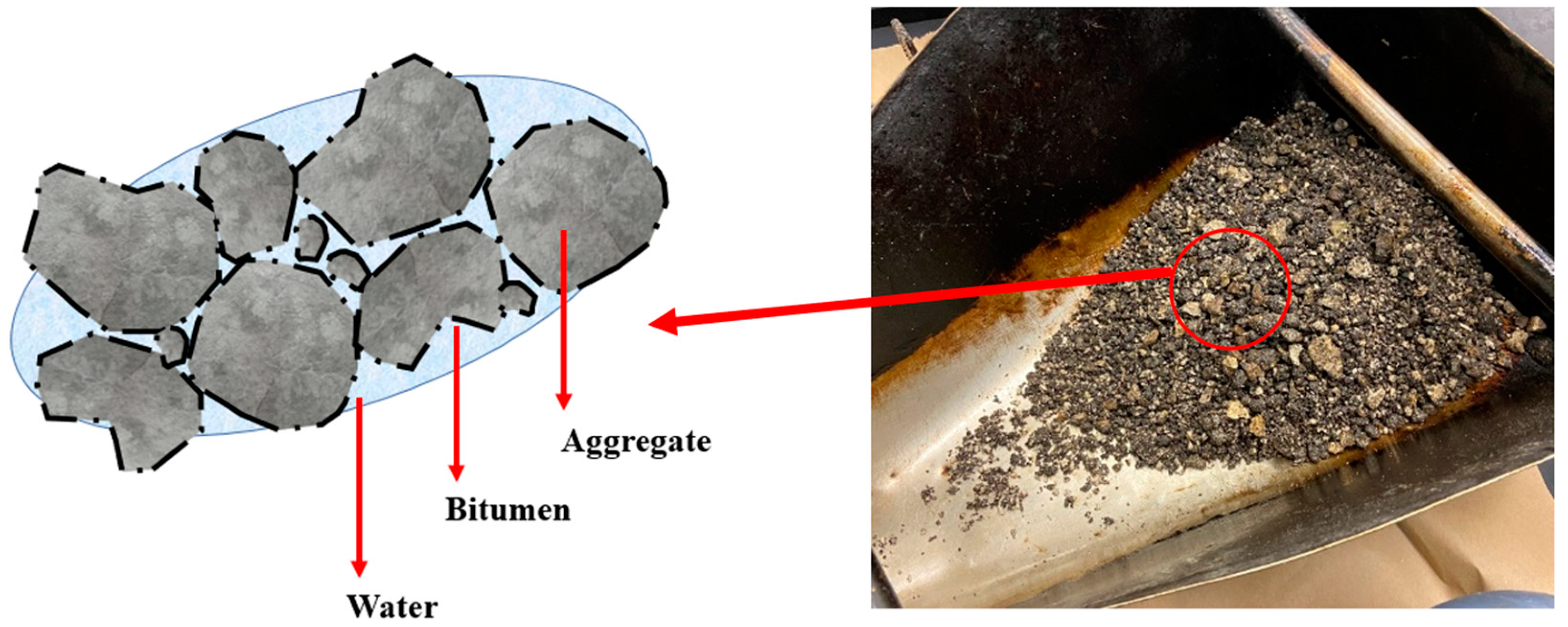

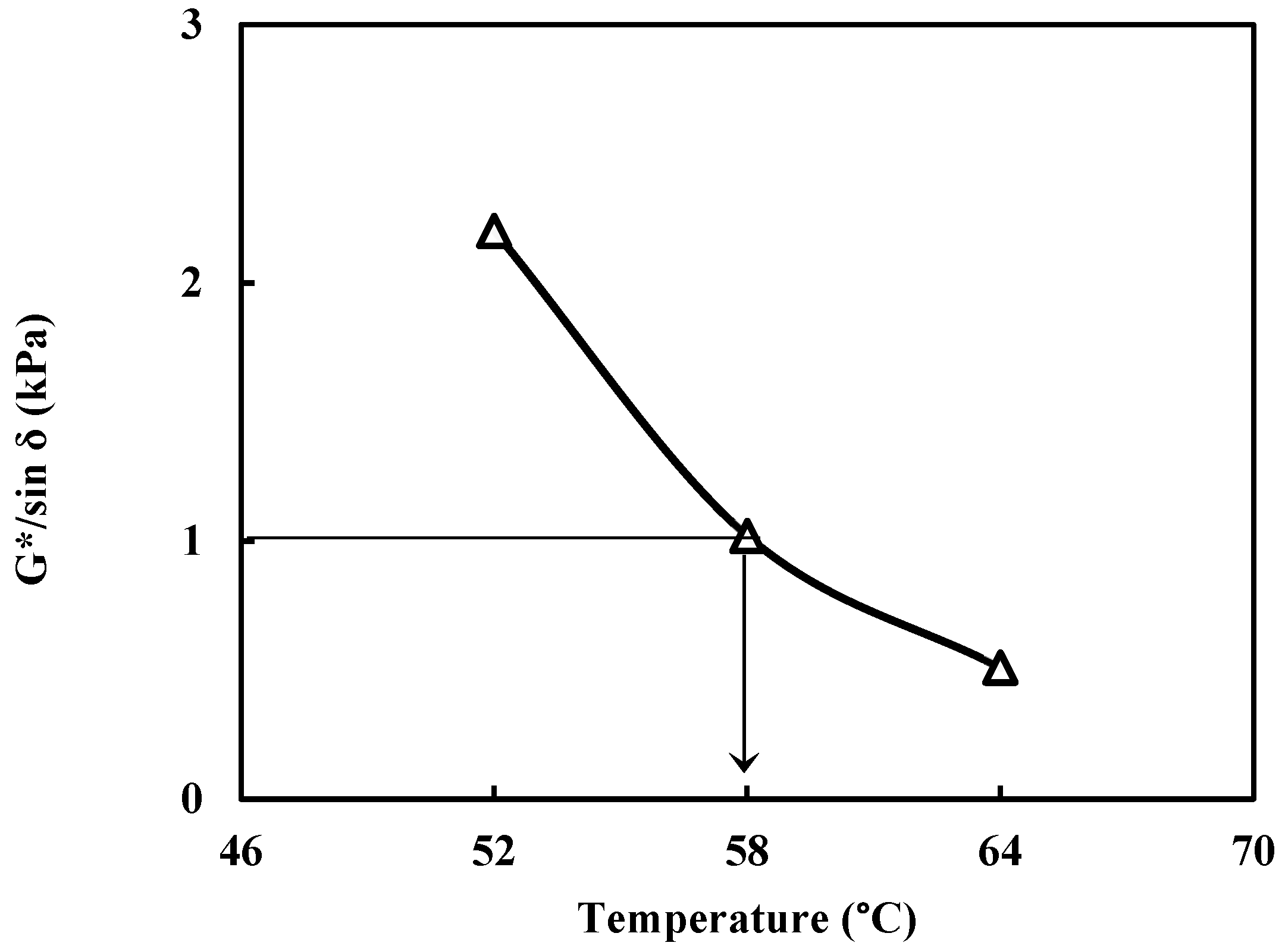
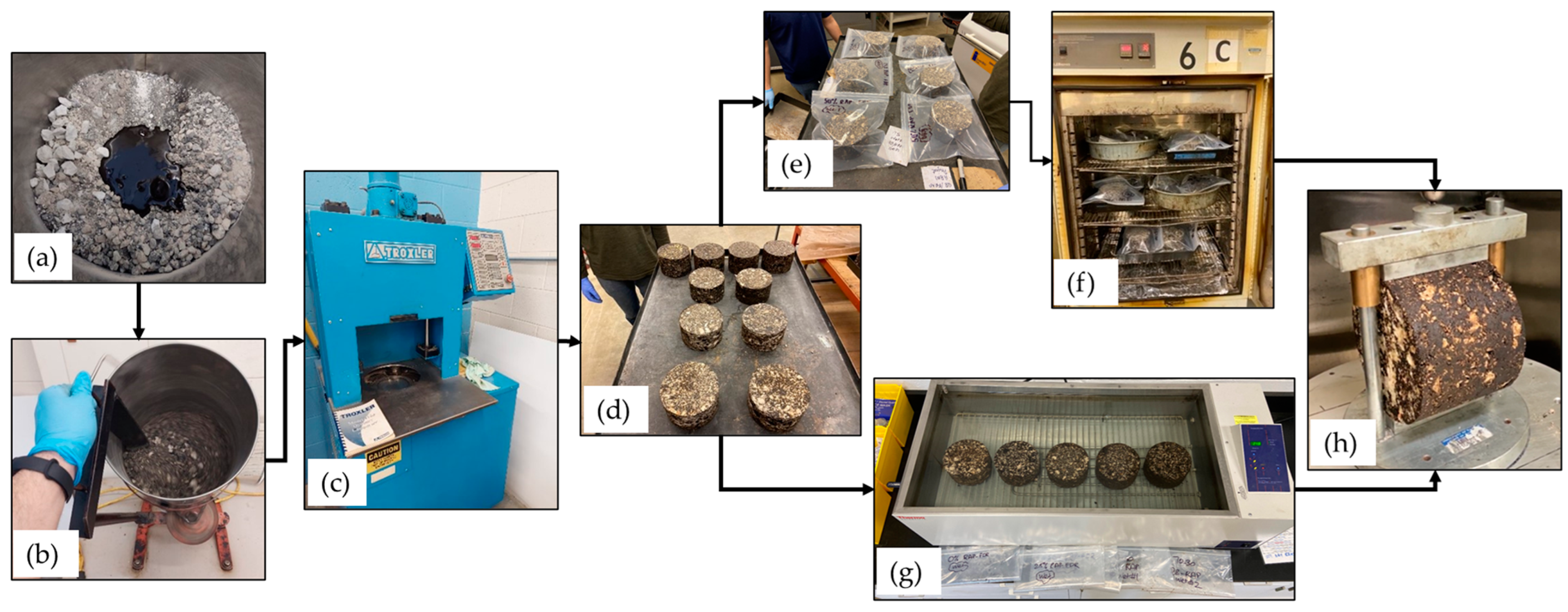
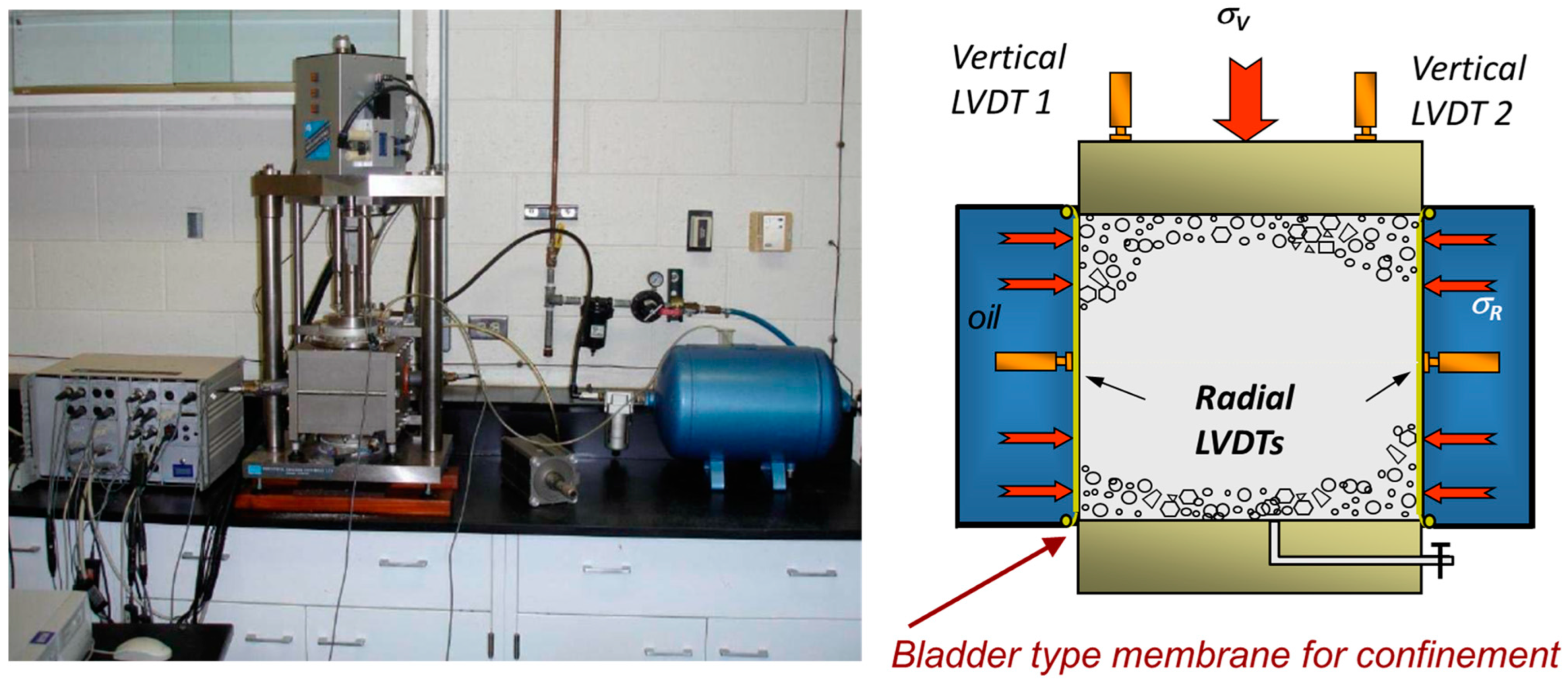

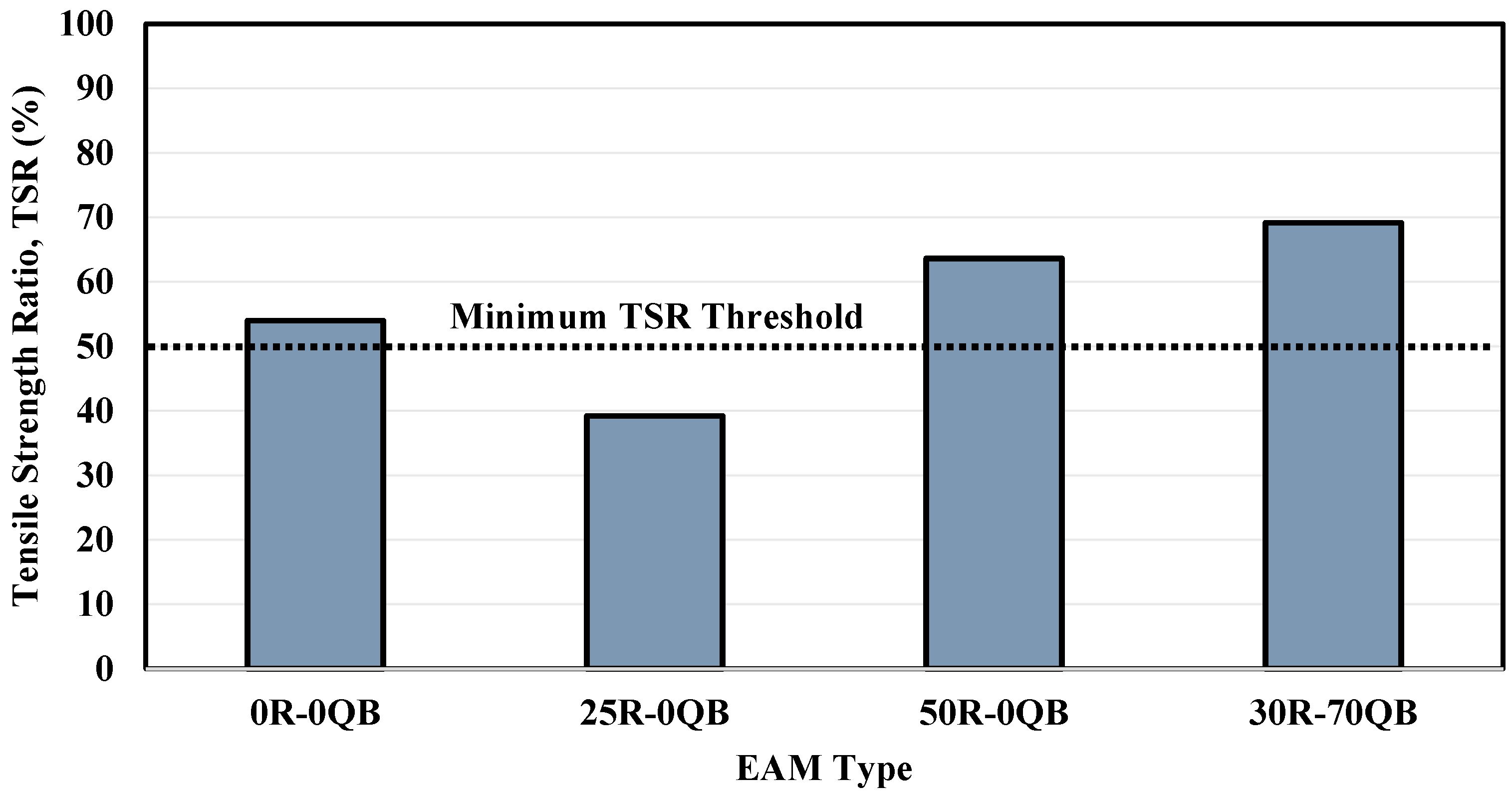
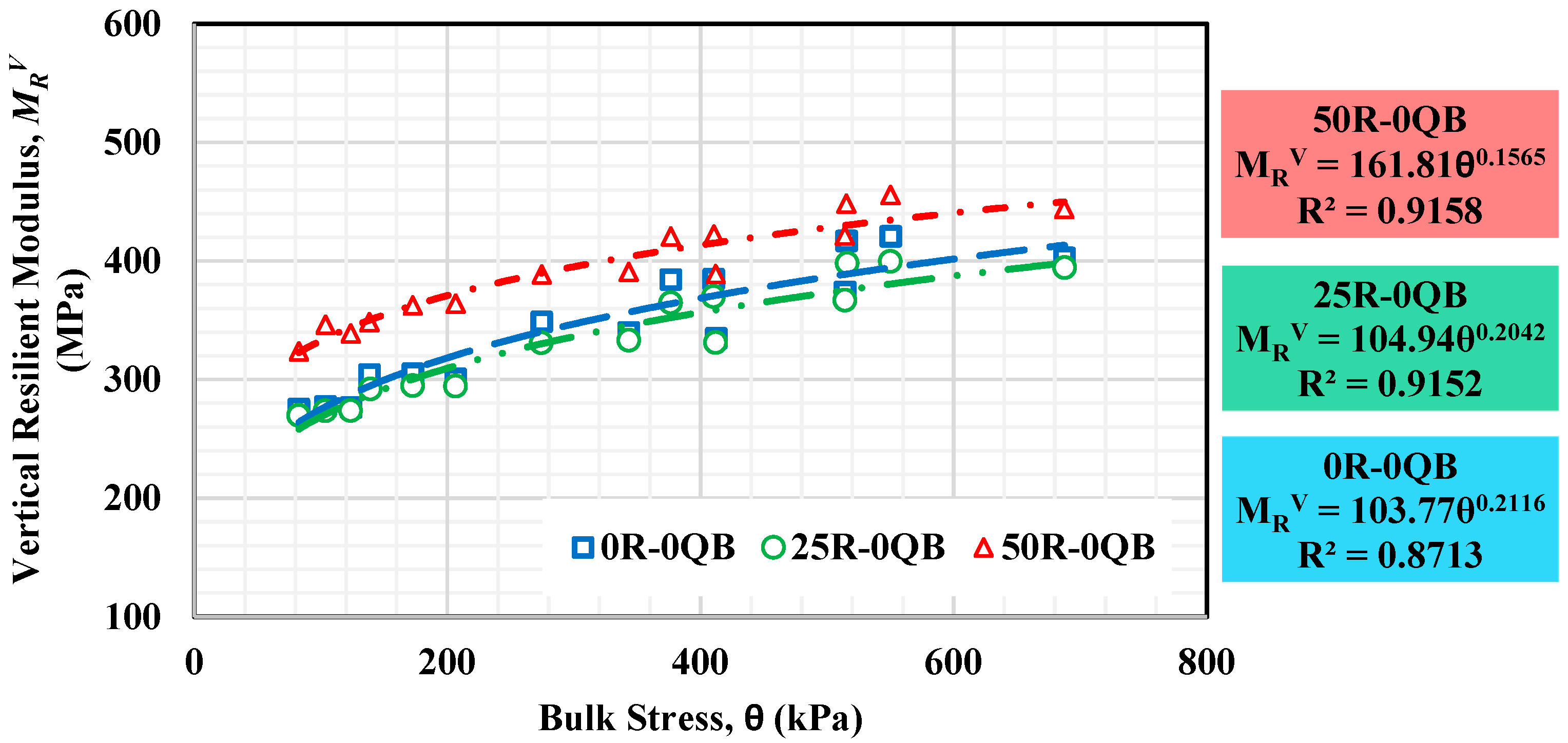
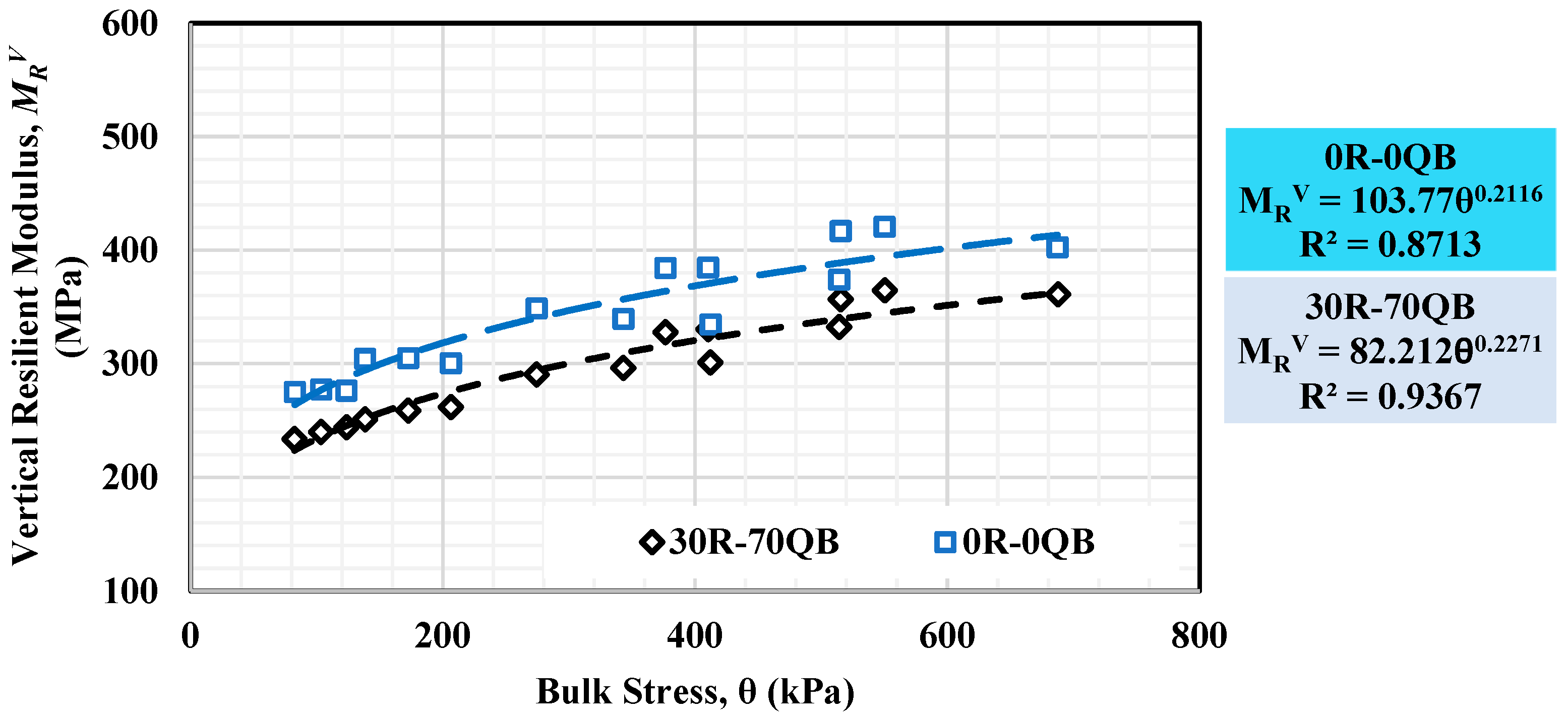
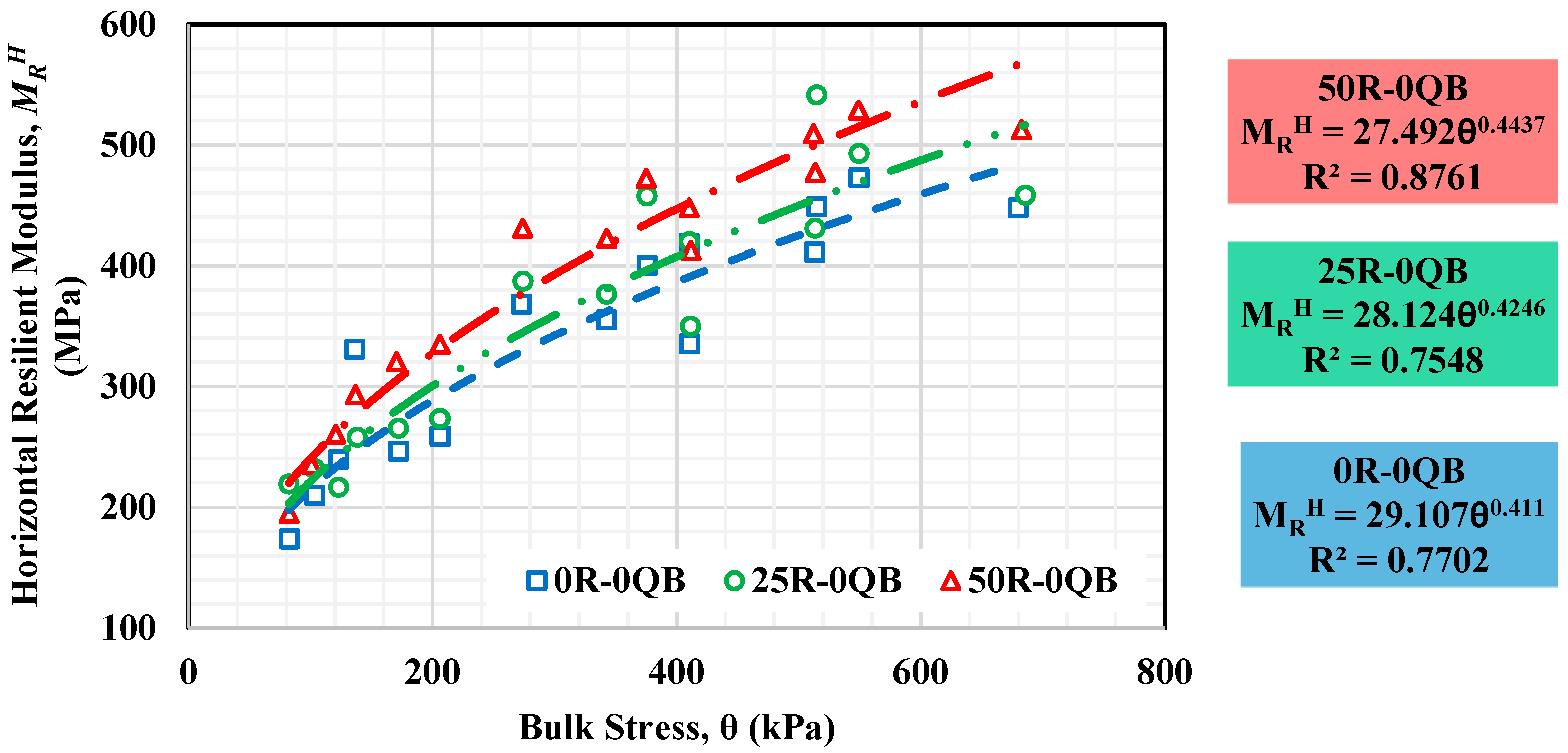
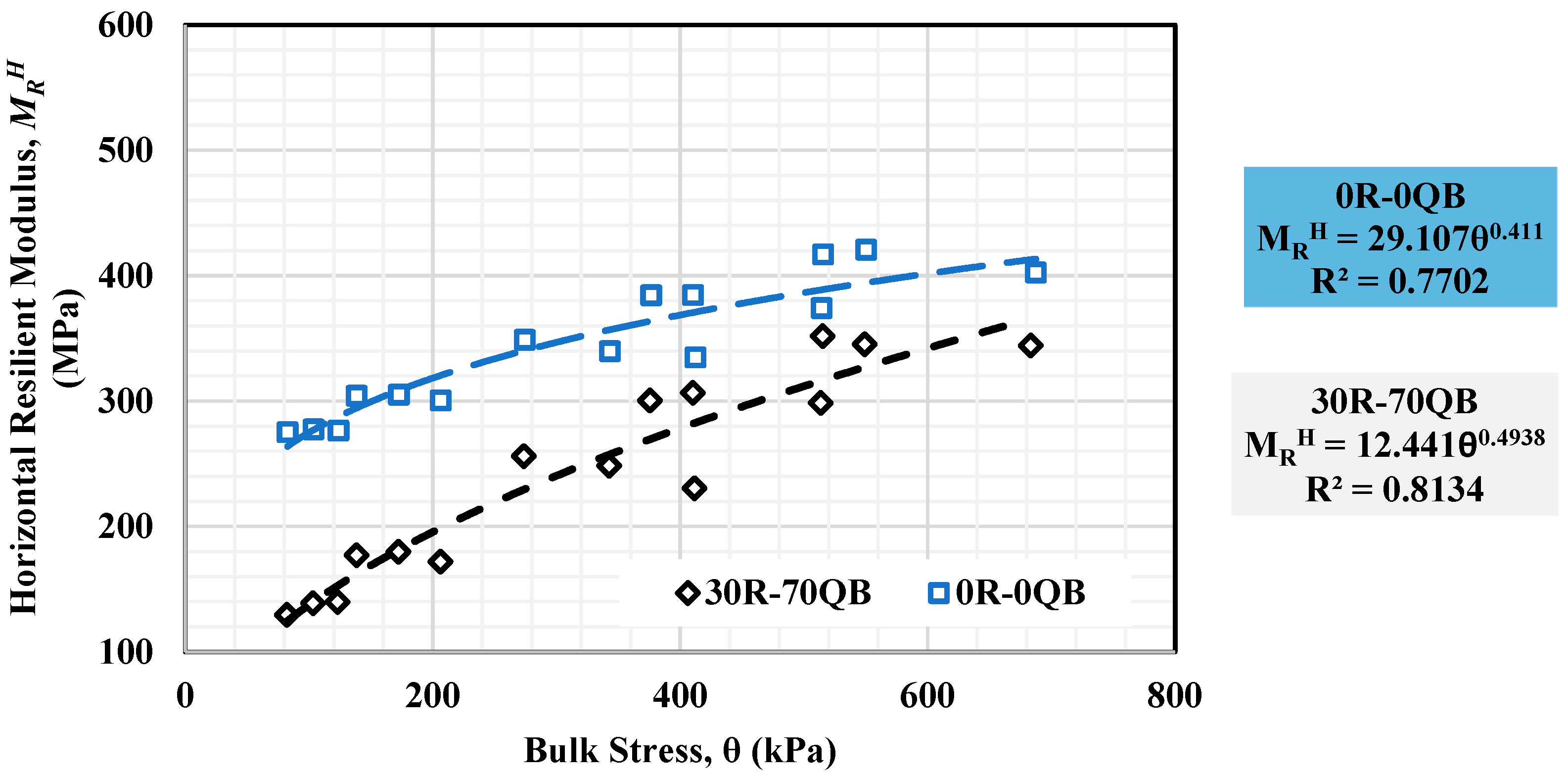


| Mixture ID | Constituents | ||
|---|---|---|---|
| Crushed Limestone (%) | FRAP (%) | QB (%) | |
| 0R-0QB | 100 | 0 | 0 |
| 25R-0QB | 75 | 25 | 0 |
| 50R-0QB | 50 | 50 | 0 |
| 30R-70QB | 0 | 30 | 70 |
| Mixture ID | Emulsion Content (%) |
|---|---|
| 0R-0QB (Control) | 5.5 |
| 25R-0QB | 4.5 |
| 50R-0QB | 3.0 |
| 30R-70QB | 5.5 |
| Sequence No. | Confining Pressure, σ3 | No. of Load Applications | |
|---|---|---|---|
| kPa | kPa | ||
| 0 | 103.4 | 103.4 | 1000 |
| 1 | 20.7 | 20.7 | 100 |
| 2 | 20.7 | 41.4 | 100 |
| 3 | 20.7 | 62.1 | 100 |
| 4 | 34.5 | 34.5 | 100 |
| 5 | 34.5 | 68.9 | 100 |
| 6 | 34.5 | 103.4 | 100 |
| 7 | 68.9 | 68.9 | 100 |
| 8 | 68.9 | 137.9 | 100 |
| 9 | 68.9 | 206.8 | 100 |
| 10 | 103.4 | 68.9 | 100 |
| 11 | 103.4 | 103.4 | 100 |
| 12 | 103.4 | 206.8 | 100 |
| 13 | 137.9 | 103.4 | 100 |
| 14 | 137.9 | 137.9 | 100 |
| 15 | 137.9 | 275.8 | 100 |
Disclaimer/Publisher’s Note: The statements, opinions and data contained in all publications are solely those of the individual author(s) and contributor(s) and not of MDPI and/or the editor(s). MDPI and/or the editor(s) disclaim responsibility for any injury to people or property resulting from any ideas, methods, instructions or products referred to in the content. |
© 2023 by the authors. Licensee MDPI, Basel, Switzerland. This article is an open access article distributed under the terms and conditions of the Creative Commons Attribution (CC BY) license (https://creativecommons.org/licenses/by/4.0/).
Share and Cite
Husain, S.F.; Qamhia, I.I.A.; Vyas, A.; Maia, R.S.; Tutumluer, E.; Hajj, R. Emulsion Mixtures of Fractionated Reclaimed Asphalt Pavement and Quarry By-Products: A Laboratory Evaluation. Sustainability 2023, 15, 10735. https://doi.org/10.3390/su151310735
Husain SF, Qamhia IIA, Vyas A, Maia RS, Tutumluer E, Hajj R. Emulsion Mixtures of Fractionated Reclaimed Asphalt Pavement and Quarry By-Products: A Laboratory Evaluation. Sustainability. 2023; 15(13):10735. https://doi.org/10.3390/su151310735
Chicago/Turabian StyleHusain, Syed Faizan, Issam I. A. Qamhia, Abhilash Vyas, Renan Santos Maia, Erol Tutumluer, and Ramez Hajj. 2023. "Emulsion Mixtures of Fractionated Reclaimed Asphalt Pavement and Quarry By-Products: A Laboratory Evaluation" Sustainability 15, no. 13: 10735. https://doi.org/10.3390/su151310735







